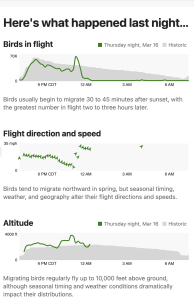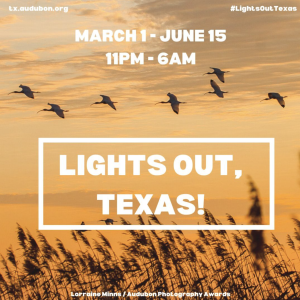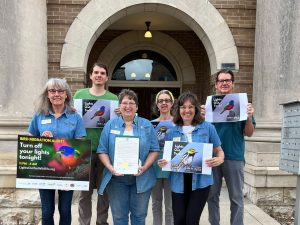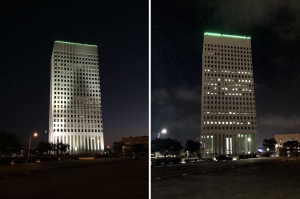Lights Out, Texas!
Imagine more than 50,000 birds flying over your house every night while you eat dinner or watch TV, or sleep. If you live in Hays County, that’s exactly what is occurring. On the night of March 16 alone, an estimated 56,500 migrating birds were picked up on radar between 7:40 p.m. and 7:40 a.m. Spring migration has definitely begun.
In an effort to make this migration more successful, Lights Out, Texas! Is urging everyone to turn off all non-essential lights from 11 p.m. to 6 a.m., the time when the heaviest bird traffic occurs. When lights are left on, birds can become disoriented, often striking windows or buildings, and they can waste energy calling out to each other in confusion. Although light pollution is detrimental to birds and other wildlife, including insects, year-round, it’s particularly deadly during the spring and fall migrations.
Lights Out, Texas! was launched in 2017 by Houston Audubon after an estimated 400 birds collided with the 32-story American National Insurance Company building in Galveston. In 2021, Texan by Nature collaborated with Houston Audubon and other leading organizations to facilitate Lights Out, Texas! at the statewide level, resulting in a standard approach to messaging, communication, and volunteer efforts. Today, the management of the program rests entirely with Audubon Texas.
The local coalition supporting this effort is Lights Out Hays County, a group whose advocates include Hays County, and the cities of Dripping Springs, Buda, Kyle, San Marcos, Wimberley, and Woodcreek. Also supporting the campaign are Hays County Master Naturalists, Hays County Friends of the Night Sky, Wimberley Valley Dark Sky Committee, Vista Brewing, Wild Birds Unlimited of Dripping Springs, Beerburg Brewing, Huth Avian, San Marcos Bluebonnet Lions Club, Mystic River Ranch, Wimberley Birding Society, Wild Spirit Wild Places Foundation, and The Meadows Center for Water and the Environment.
How to Participate
Spring Migration: March 1 – June 15, 2023
Peak Migration: April 22 – May 12, 2023
- Turn off all non-essential lights from 11:00 p.m. to 6:00 a.m. each night during migration season
- Do not use landscape lighting to light up trees or gardens where birds may be nesting
For essential lights (like security and safety lighting) use the following dark skies-friendly lighting practices:
- Aim lights down
- Use lighting shields to direct light downwards and avoid light shining into the sky or trees
- Use motion detectors and sensors so lights are on only when you need them
- Close blinds at night to reduce the amount of light being emitted from windows
You can find examples of dark skies-friendly lighting from the International Dark Sky Association and additional guidance and language regarding dark skies from the McDonald Observatory’s dark skies resources and recommended lighting practices.
If you own or manage a building, consider the following for custodial services:
- Consider adjusting custodial schedules to end by 11:00 pm
- Ask custodial staff to ensure that lights are off after they finish their work
ADDITIONAL GUIDELINES FOR BUILDINGS TALLER THAN 3 STORIES
Extinguish or dim:
- Exterior and decorative lighting (i.e. spotlights, logos, clock faces, greenhouses, and antenna lighting)
- Lobby/atrium lighting
- Lighting in perimeter rooms on all levels of the building
Avoid:
- Floodlights
- Illuminating interior plants or fountains
- Illuminating unoccupied floors
- Lights with blue-rich white light emissions (lighting with a color temperature of over 3000 Kelvin)
Use:
- Desk lamps or task lighting rather than overhead lights
- Blinking lighting in place of continuously burning lights
- Warm light sources (less than 3000 Kelvin) for outdoor lighting
BirdCast

 To get a better picture of the migration through your area, visit the BirdCast dashboard, a project that began as a collaboration among the EPA, the National Audubon Society, Cornell Lab of Ornithology, Clemson University Radar Ornithology Laboratory, the Academy of Natural Sciences in Philadelphia, GeoMarine, Inc., and others.
To get a better picture of the migration through your area, visit the BirdCast dashboard, a project that began as a collaboration among the EPA, the National Audubon Society, Cornell Lab of Ornithology, Clemson University Radar Ornithology Laboratory, the Academy of Natural Sciences in Philadelphia, GeoMarine, Inc., and others.
To use BirdCast, simply input the name of your county and click. You’ll be taken to a page that will show not only the number of birds that migrated through your county the previous night, but also how high and fast they flew. Other information includes total number of migrants for the season, compared to the historical average; peak migration traffic; and species expected to come through each month. In Hays County, for example, expected nocturnal migrants are ring-necked ducks, American wigeons, savannah sparrows, yellow-rumped warblers, and spotted towhees, among others.




